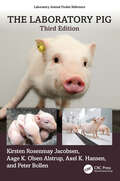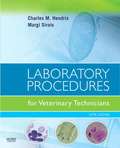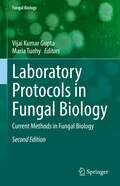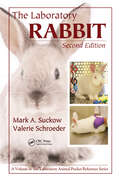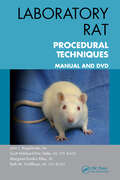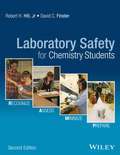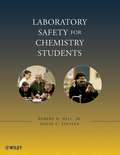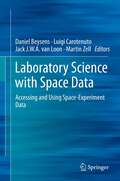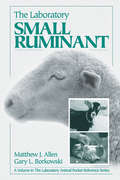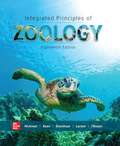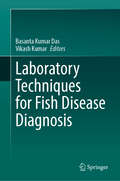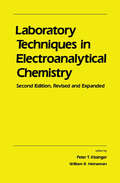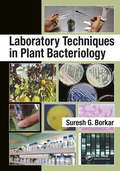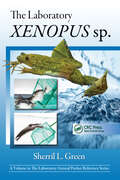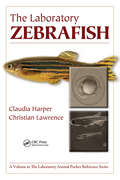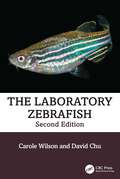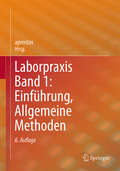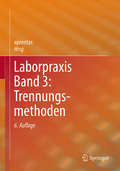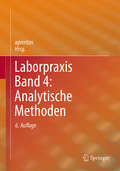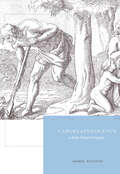- Table View
- List View
The Laboratory Pig (Laboratory Animal Pocket Reference)
by Kirsten Rosenmay Jacobsen Aage K Olsen Alstrup Axel K. Hansen Peter BollenSince the popular second edition of The Laboratory Swine was published more than a decade ago, the number of pigs used in toxicity studies has increased as an alternative to commonly used non-rodent species, while, at the same time, large developments have been made in welfare concepts of laboratory animals. Pigs have gained prominence in both basic and applied research, leading to a significant increase in publication activity.This third edition summarizes these new insights, raising the bar for humane care and use of pigs, from agricultural sources to genetically and microbiological defined minipigs. Aimed at animal caretakers, technicians, laboratory animal veterinarians, and investigators planning and performing studies on pigs, it provides an overview with extensive references for further study. The book has been updated with a special focus on refined methods for housing and handling pigs, including an updated description of commonly performed experimental and surgical procedures.Continuing its legacy as the premier reference on the care and use of pigs in the laboratory, the small, practical, and accessible format makes this an easy "go-to" book, with easy-to-find information and high-quality color images. The third edition aims to contribute to humane use and care for laboratory pigs in all aspects of housing, husbandry, veterinary care, and experimental techniques.
Laboratory Procedures for Veterinary Technicians (5th edition)
by Charles M. Hendrix Margi SiroisFive American academics contribute nine chapters to an updated text for practicing veterinary technicians, veterinary assistants, and veterinary technology students. The text covers principles and procedures for laboratory diagnostics in the areas of clinical chemistry, microbiology, hematology, homeostasis, parasitology, urinalysis, immunology, and cytology. It assumes a basic understanding of the anatomy and physiology of common species. The new edition has been significantly updated with expanded information reflecting the latest developments in the veterinary clinical laboratory since publication of the 2002 edition. It includes new sections on laboratory mathematics, hematopoiesis, molecular diagnostics, and the physiologic basis of immunity; expanded information on clinical analyzers and quality assurance; and information on professional associations related to veterinary clinical pathology. Illustrated with full color and b&w photomicrographs, charts, and diagrams. Annotation ©2008 Book News, Inc., Portland, OR (booknews.com)
Laboratory Protocols in Fungal Biology: Current Methods in Fungal Biology (Fungal Biology)
by Vijai Kumar Gupta Maria TuohyMycology has an integral role to play in the development of the biotechnology and biomedical sectors. It has become a subject of increasing importance as new fungi and their associated biomolecules are identified. As this discipline comes to the forefront of research in these sectors, the requirement for a consolidation of available research approaches is required. The First Edition of this book has a few basic and applied protocols. With the Second Edition, this book provides consolidated information on recent developments and the most widely used mycological methods available in the fields of biochemistry, biotechnology and microbiology. The methods outlined offer clear and concise directions to the reader and covers both standard protocols and more applied mycological methods. This book provides useful information for undergraduates, post-graduates, and specialists and researchers studying fungal biology.
Laboratory Protocols in Fungal Biology
by Maria G. Tuohy Anthonia O’donovan Vijai Kumar Gupta Kevin M. Turner Manimaran AyyachamyLaboratory Protocols in Fungal Biology presents the latest techniques in fungal biology. This book analyzes information derived through real experiments, and focuses on cutting edge techniques in the field. The book comprises 57 chapters contributed from internationally recognised scientists and researchers. Experts in the field have provided up-to-date protocols covering a range of frequently used methods in fungal biology. Almost all important methods available in the area of fungal biology viz. taxonomic keys in fungi; histopathological and microscopy techniques; proteomics methods; genomics methods; industrial applications and related techniques; and bioinformatics tools in fungi are covered and complied in one book. Chapters include introductions to their respective topics, list of the necessary materials and reagents, step-by-step, readily reproducible laboratory protocols, and notes on troubleshooting. Each chapter is self-contained and written in a style that enables the reader to progress from elementary concepts to advanced research techniques. Laboratory Protocols in Fungal Biology is a valuable tool for both beginner research workers and experienced professionals.
The Laboratory Rabbit (Laboratory Animal Pocket Reference)
by Mark A. Suckow Valerie Schroeder Fred A. DouglasWith laboratory animals, especially rabbits, playing such an important role in biomedical research, the humane care of these animals is an ongoing concern. The Laboratory Rabbit, Second Edition presents basic information and common procedures in detail to provide a quick reference for caretakers, technicians, and researchers in a laboratory setting
The Laboratory Rat (Laboratory Animal Pocket Reference)
by Patrick Sharp Jason S. VillanoRats have long been recognized as a valuable biomedical research model, notably in the investigation of aging, toxicology, addiction, and common human diseases such as diabetes and hypertension. In many instances, individuals conducting such research studies are charged with important responsibilities, including animal facility management, animal h
Laboratory Rat Procedural Techniques: Manual and DVD
by John J. Bogdanske Scott Hubbard-Van Stelle Margaret Rankin Riley Beth SchiffmanThis combination manual and downloadable resources provide much-needed training on the proper handling of rats used in biomedical research. The downloadable resources include narrated video clips that demonstrate and describe each procedural technique. The manual contains handouts with color illustrations and descriptive text for each technique, including the purpose and application of the procedure, recommended skills, and necessary supplies. It can be used as a training resource and refresher for lab animal veterinarians, veterinary technicians, animal care staff, trainers, and research investigators and staff who work with rats.
Laboratory Safety for Chemistry Students
by Robert H. Hill Jr. David C. FinsterProvides knowledge and models of good practice needed by students to work safely in the laboratory as they progress through four years of undergraduate laboratory work Aligns with the revised safety instruction requirements from the ACS Committee on Professional Training 2015 "Guidelines and Evaluation Procedures for Bachelor's Degree Programs" Provides a systematic approach to incorporating safety and health into the chemistry curriculum Topics are divided into layers of progressively more advanced and appropriate safety issues so that some topics are covered 2-3 times, at increasing levels of depth Develops a strong safety ethic by continuous reinforcement of safety; to recognize, assess, and manage laboratory hazards; and to plan for response to laboratory emergencies Covers a thorough exposure to chemical health and safety so that students will have the proper education and training when they enter the workforce or graduate school
Laboratory Safety for Chemistry Students
by Robert H. Hill David Finster"...this substantial and engaging text offers a wealth of practical (in every sense of the word) advice...Every undergraduate laboratory, and, ideally, every undergraduate chemist, should have a copy of what is by some distance the best book I have seen on safety in the undergraduate laboratory." Chemistry World, March 2011Laboratory Safety for Chemistry Students is uniquely designed to accompany students throughout their four-year undergraduate education and beyond, progressively teaching them the skills and knowledge they need to learn their science and stay safe while working in any lab. This new principles-based approach treats lab safety as a distinct, essential discipline of chemistry, enabling you to instill and sustain a culture of safety among students. As students progress through the text, they'll learn about laboratory and chemical hazards, about routes of exposure, about ways to manage these hazards, and about handling common laboratory emergencies. Most importantly, they'll learn that it is very possible to safely use hazardous chemicals in the laboratory by applying safety principles that prevent and minimize exposures.Continuously Reinforces and Builds Safety Knowledge and Safety CultureEach of the book's eight chapters is organized into three tiers of sections, with a variety of topics suited to beginning, intermediate, and advanced course levels. This enables your students to gather relevant safety information as they advance in their lab work. In some cases, individual topics are presented more than once, progressively building knowledge with new information that's appropriate at different levels.A Better, Easier Way to Teach and Learn Lab SafetyWe all know that safety is of the utmost importance; however, instructors continue to struggle with finding ways to incorporate safety into their curricula. Laboratory Safety for Chemistry Students is the ideal solution: Each section can be treated as a pre-lab assignment, enabling you to easily incorporate lab safety into all your lab courses without building in additional teaching time.Sections begin with a preview, a quote, and a brief description of a laboratory incident that illustrates the importance of the topic.References at the end of each section guide your students to the latest print and web resources.Students will also find "Chemical Connections" that illustrate how chemical principles apply to laboratory safety and "Special Topics" that amplify certain sections by exploring additional, relevant safety issues.Visit the companion site at http://userpages.wittenberg.edu/dfinster/LSCS/.
Laboratory Science with Space Data
by Martin Zell Luigi Carotenuto Jack J.W.A. van Loon Daniel BeysensFor decades experiments conducted on space stations like MIR and the ISS have been gathering data in many fields of research in the natural sciences, medicine and engineering. The EU-sponsored Ulisse Internet Portal provides metadata from space experiments of all kinds and links to the data. Complementary to the portal, this book will serve as handbook listing space experiments by type of infrastructure, area of research in the life and physical sciences, data type, what their mission was, what kind of data they have collected and how one can access this data through Ulisse for further research. The book will provide an overview of the wealth of space experiment data that can be used for research, and will inspire academics (e.g. those looking for topics for their PhD thesis) and research departments in companies for their continued development.
The Laboratory Small Ruminant (Laboratory Animal Pocket Reference)
by Matthew J. Allen Gary L. BorkowskiThe Laboratory Small Ruminant details basic information and common procedures for individuals performing research with small ruminants. Details include duties of animal husbandry, regulatory compliance, and technical procedures. It is designed to assist in the humane care and use of small ruminants in the laboratory and to provide immediate informa
Laboratory Studies for Animal Diversity (Sixth Edition)
by Lee Kats Susan Keen Cleveland P. HickmanLaboratory Studies in Animal Diversity offers students hands-on experience in learning about the diversity of life. It provides students the opportunity to become acquainted with the principal groups of animals and to recognize the unique anatomical features that characterize each group as well as the patterns that link animal groups to each other.
Laboratory Studies In Integrated Principles Of Zoology
by Cleveland P. Hickman Larry S. Roberts Allan Larson Helen I'AnsonLaboratory Studies in Integrated Principles of Zoology textbook.
The Laboratory Swine (Laboratory Animal Pocket Reference)
by Peter J. Bollen Axel K. Hansen Aage K Olsen AlstrupAddressing the biology, husbandry, management, veterinary care and research applications of both large and miniature swine, this color resource is renowned as the laboratory reference on swine. It is thoroughly updated and includes a major revision to the anesthetics section. It also places a heightened focus on animal welfare and addresses important considerations related to genetically modified swine. The Laboratory Swine, Second Edition is ideal for animal caretakers, technicians, investigators, and laboratory animal veterinarians as a single-source reference that contributes to the humane care and use of swine in research.
Laboratory Techniques for Fish Disease Diagnosis
by Vikash Kumar Basanta Kumar DasThis book covers various aspects of fish health, disease identification and laboratory procedures. Each section of the book is detailed and includes practical information, step-by-step procedures and relevant illustrations and diagrams. The recent updates on fish disease diagnosis have been incorporated to address new techniques and technologies in the field. Fish disease diagnosis is primarily based on the color and characteristics in the image to target the infected area. It is an indispensable part of modern aquaculture, and rapid and real-time diagnosis is an essential part of the early and precise treatment of the diseases. As farmed fishes are affected by viruses, bacteria, parasites, metal pollution, and fishing damage, accurate disease diagnosis is crucial for effective management interventions. It often requires a combination of clinical expertise, advanced technology, and collaboration among healthcare professionals. This book is a comprehensive guide for students, researchers and professionals involved in fish disease diagnosis.
Laboratory Techniques in Electroanalytical Chemistry, Revised and Expanded
by Peter Kissinger William R. HeinemanThis volume provides a practical, intuitive approach to electroanalytical chemistry, presenting fundamental concepts and experimental techniques without the use of technical jargon or unnecessarily extensive mathematics. This edition offers new material on ways of preparing and using microelectrodes, the processes that govern the voltammetric behavior of microelectrodes, methods for characterizing chemically modified electrodes, electrochemical studies at reduced temperatures, and more. <P><P>The authors cover such topics as analog instrumentation, overcoming solution resistance with stability and grace in potentiostatic circuits, conductivity and conductometry, electrochemical cells, carbon electrodes, film electrodes, microelectrodes, chemically modified electrodes, mercury electrodes, and solvents and supporting electrolytes.
Laboratory Techniques in Plant Bacteriology
by Suresh G. BorkarLaboratory Techniques in Plant Bacteriology is ideal for scientists and students who seek a career in plant pathogenic bacteria. This book contains 41 chapters comprising practicable techniques from isolation of bacterial plant pathogens to their identification up to species and race/biotype level. It includes identification protocols of morphological, biochemical, immunological, and molecular-based techniques. This book comprises all technological aspects of plant bacteriological studies. Its content is ideal for graduate students and research scholars including bacteriological professionals or technicians. The book ultimately provides working technologies useful for controlling bacterial disease pathogens.
The Laboratory Xenopus sp. (Laboratory Animal Pocket Reference)
by Sherril L. GreenXenopus have gained increasing popularity as a laboratory animal and continue to serve as an important part of biomedical research. This book offers a practical reference to the care and maintenance of captive clawed frogs. With full-color illustrations of management practices and technical procedures, the text explores the wide range of responsibilities facing individuals who work with this species, from husbandry, compliance, and veterinary care to housing and water quality management. Numerous figures and tables enhance understanding of concepts. An experienced researcher at a top tier institution, the author provides an invaluable guide for facility technicians and animal caretakers.
The Laboratory Zebrafish (Laboratory Animal Pocket Reference)
by Claudia Harper Christian LawrenceLike other books in the Laboratory Animal Pocket Reference Series, this guide covers all aspects pertaining to the use of these organisms including their basic biology, humane care and management, husbandry, life support systems, regulatory compliance, technical procedures, veterinary care, and water quality management. In the relatively brief span
The Laboratory Zebrafish (Laboratory Animal Pocket Reference)
by Carole Wilson David ChuThis guide covers all aspects pertaining to the use of zebrafish including their basic biology, humane care and management, husbandry, life support systems, regulatory compliance, technical procedures, veterinary care, and water quality management. The zebrafish is now a mainstream model animal employed by scientists to study everything from stem cells to the basis of behavioral changes induced by drug addiction. However, there are few accepted and established standards for husbandry, management, and care for the fish in laboratory settings and even fewer comprehensive and constantly reliable resources. To this end, the goal of this handbook is to provide managers, veterinarians, investigators, technicians, and regulatory personnel with a concise yet thorough reference on zebrafish biology, care, husbandry, and management. The new edition includes more figures, tables and bullet points, a wealth of new full-color images, major updates on health and welfare (including colony health surveillance and viruses), and a complete overhaul of the compliance section to address more international concerns.
Laborpraxis Band 1: Einführung, Allgemeine Methoden
by AprentasDas vierbändige Standardwerk für die grundlegende praktische Arbeit im chemisch-pharmazeutischen Labor mit Schwerpunkt Synthesemethoden, Chromatographie und Spektroskopie liegt jetzt in der 6. völlig neu überarbeiteten Auflage vor. Es dient Berufseinsteigern als breit angelegtes Lehrmittel und erfahrenen Fachkräften als Nachschlagewerk mit übersichtlich dargestellten theoretischen Grundlagen und konkreten, erprobten Anwendungsideen. Die theoretischen Grundlagen für jedes Kapitel sind gut lesbar abgefasst und unterstützen das Verständnis für praktische Arbeiten und Gerätefunktionen. Zu jedem Kapitel gibt es Hinweise auf vertiefende und weiterführende Literatur. Arbeitssicherheit und –hygiene sowie die zwölf Prinzipien der nachhaltigen Chemie finden neben den entsprechenden Kapiteln Beachtung. Die im Buch erwähnten praktischen Grundlagen gründen auf Gegebenheiten in der chemisch-pharmazeutischen Industrie in der Schweiz. Sie finden im gesamten deutschsprachigen Raum Anwendung, auch in verwandten Arbeitsgebieten wie biochemischen, klinischen, werkstoffkundlichen oder universitären Laboratorien. Die Laborpraxis eignet sich für den Einsatz in der Grund- und in der Weiterbildung von Fachpersonal. Der Inhalt entspricht den aktuellen Anforderungen der Bildungsverordnung und des Bildungsplanes zum Beruf Laborantin / Laborant mit eidgenössischem Fähigkeitszeugnis (EFZ), welche vom Staatssekretariat für Bildung, Forschung und Innovation (SBFI) in Bern verordnet wurden. Damit steht den Lernenden eine gute Grundlage für die Vorbereitung auf das Qualifikationsverfahren (QV) zur Verfügung; Expertinnen und Experten stützen ihre persönlichen Vorbereitungsarbeiten und ihre fachlichen Beurteilungen auf dieses Buch. Band 1 und Band 2 behandeln ausführlich die Grundlagen der Laborarbeit und ausgewählte Messtechniken. Band 3 ist auf präparative und analytische Trennungsmethoden, Band 4 auf nasschemische und spektroskopische Analysemethoden fokussiert. Sowohl konventionelle Methoden als auch modernste Techniken finden Erwähnung. Der Fokus auf beständig gültigen Prinzipien erlaubt auch neue, nicht erwähnte Techniktrends zu verstehen sowie die tägliche Arbeit im chemisch-pharmazeutischen Labor zu reflektieren.
Laborpraxis Band 2: Messmethoden
by AprentasDas vierbändige Standardwerk für die grundlegende praktische Arbeit im chemisch-pharmazeutischen Labor mit Schwerpunkt Synthesemethoden, Chromatographie und Spektroskopie liegt jetzt in der 6. völlig neu überarbeiteten Auflage vor. Es dient Berufseinsteigern als breit angelegtes Lehrmittel und erfahrenen Fachkräften als Nachschlagewerk mit übersichtlich dargestellten theoretischen Grundlagen und konkreten, erprobten Anwendungsideen. Die theoretischen Grundlagen für jedes Kapitel sind gut lesbar abgefasst und unterstützen das Verständnis für praktische Arbeiten und Gerätefunktionen. Zu jedem Kapitel gibt es Hinweise auf vertiefende und weiterführende Literatur. Arbeitssicherheit und –hygiene sowie die zwölf Prinzipien der nachhaltigen Chemie finden neben den entsprechenden Kapiteln Beachtung. Die im Buch erwähnten praktischen Grundlagen gründen auf Gegebenheiten in der chemisch-pharmazeutischen Industrie in der Schweiz. Sie finden im gesamten deutschsprachigen Raum Anwendung, auch in verwandten Arbeitsgebieten wie biochemischen, klinischen, werkstoffkundlichen oder universitären Laboratorien. Die Laborpraxis eignet sich für den Einsatz in der Grund- und in der Weiterbildung von Fachpersonal. Der Inhalt entspricht den aktuellen Anforderungen der Bildungsverordnung und des Bildungsplanes zum Beruf Laborantin / Laborant mit eidgenössischem Fähigkeitszeugnis (EFZ), welche vom Staatssekretariat für Bildung, Forschung und Innovation (SBFI) in Bern verordnet wurden. Damit steht den Lernenden eine gute Grundlage für die Vorbereitung auf das Qualifikationsverfahren (QV) zur Verfügung; Expertinnen und Experten stützen ihre persönlichen Vorbereitungsarbeiten und ihre fachlichen Beurteilungen auf dieses Buch. Band 1 und Band 2 behandeln ausführlich die Grundlagen der Laborarbeit und ausgewählte Messtechniken. Band 3 ist auf präparative und analytische Trennungsmethoden, Band 4 auf nasschemische und spektroskopische Analysemethoden fokussiert. Sowohl konventionelle Methoden als auch modernste Techniken finden Erwähnung. Der Fokus auf beständig gültigen Prinzipien erlaubt auch neue, nicht erwähnte Techniktrends zu verstehen sowie die tägliche Arbeit im chemisch-pharmazeutischen Labor zu reflektieren.
Laborpraxis Band 3: Trennungsmethoden
by AprentasDas vierbändige Standardwerk für die grundlegende praktische Arbeit im chemisch-pharmazeutischen Labor mit Schwerpunkt Synthesemethoden, Chromatographie und Spektroskopie liegt jetzt in der 6. völlig neu überarbeiteten Auflage vor. Es dient Berufseinsteigern als breit angelegtes Lehrmittel und erfahrenen Fachkräften als Nachschlagewerk mit übersichtlich dargestellten theoretischen Grundlagen und konkreten, erprobten Anwendungsideen. Die theoretischen Grundlagen für jedes Kapitel sind gut lesbar abgefasst und unterstützen das Verständnis für praktische Arbeiten und Gerätefunktionen. Zu jedem Kapitel gibt es Hinweise auf vertiefende und weiterführende Literatur. Arbeitssicherheit und –hygiene sowie die zwölf Prinzipien der nachhaltigen Chemie finden neben den entsprechenden Kapiteln Beachtung. Die im Buch erwähnten praktischen Grundlagen gründen auf Gegebenheiten in der chemisch-pharmazeutischen Industrie in der Schweiz. Sie finden im gesamten deutschsprachigen Raum Anwendung, auch in verwandten Arbeitsgebieten wie biochemischen, klinischen, werkstoffkundlichen oder universitären Laboratorien.Die Laborpraxis eignet sich für den Einsatz in der Grund- und in der Weiterbildung von Fachpersonal. Der Inhalt entspricht den aktuellen Anforderungen der Bildungsverordnung und des Bildungsplanes zum Beruf Laborantin / Laborant mit eidgenössischem Fähigkeitszeugnis (EFZ), welche vom Staatssekretariat für Bildung, Forschung und Innovation (SBFI) in Bern verordnet wurden. Damit steht den Lernenden eine gute Grundlage für die Vorbereitung auf das Qualifikationsverfahren (QV) zur Verfügung; Expertinnen und Experten stützen ihre persönlichen Vorbereitungsarbeiten und ihre fachlichen Beurteilungen auf dieses Buch. Band 1 und Band 2 behandeln ausführlich die Grundlagen der Laborarbeit und ausgewählte Messtechniken. Band 3 ist auf präparative und analytische Trennungsmethoden, Band 4 auf nasschemische und spektroskopische Analysemethoden fokussiert. Sowohl konventionelle Methoden als auch modernste Techniken finden Erwähnung. Der Fokus auf beständig gültigen Prinzipien erlaubt auch neue, nicht erwähnte Techniktrends zu verstehen sowie die tägliche Arbeit im chemisch-pharmazeutischen Labor zu reflektieren.
Laborpraxis Band 4: Analytische Methoden
by AprentasDas vierbändige Standardwerk für die grundlegende praktische Arbeit im chemisch-pharmazeutischen Labor mit Schwerpunkt Synthesemethoden, Chromatographie und Spektroskopie liegt jetzt in der 6. völlig neu überarbeiteten Auflage vor. Es dient Berufseinsteigern als breit angelegtes Lehrmittel und erfahrenen Fachkräften als Nachschlagewerk mit übersichtlich dargestellten theoretischen Grundlagen und konkreten, erprobten Anwendungsideen. Die theoretischen Grundlagen für jedes Kapitel sind gut lesbar abgefasst und unterstützen das Verständnis für praktische Arbeiten und Gerätefunktionen. Zu jedem Kapitel gibt es Hinweise auf vertiefende und weiterführende Literatur. Arbeitssicherheit und –hygiene sowie die zwölf Prinzipien der nachhaltigen Chemie finden neben den entsprechenden Kapiteln Beachtung. Die im Buch erwähnten praktischen Grundlagen gründen auf Gegebenheiten in der chemisch-pharmazeutischen Industrie in der Schweiz. Sie finden im gesamten deutschsprachigen Raum Anwendung, auch in verwandten Arbeitsgebieten wie biochemischen, klinischen, werkstoffkundlichen oder universitären Laboratorien. Die Laborpraxis eignet sich für den Einsatz in der Grund- und in der Weiterbildung von Fachpersonal. Der Inhalt entspricht den aktuellen Anforderungen der Bildungsverordnung und des Bildungsplanes zum Beruf Laborantin / Laborant mit eidgenössischem Fähigkeitszeugnis (EFZ), welche vom Staatssekretariat für Bildung, Forschung und Innovation (SBFI) in Bern verordnet wurden. Damit steht den Lernenden eine gute Grundlage für die Vorbereitung auf das Qualifikationsverfahren (QV) zur Verfügung; Expertinnen und Experten stützen ihre persönlichen Vorbereitungsarbeiten und ihre fachlichen Beurteilungen auf dieses Buch. Band 1 und Band 2 behandeln ausführlich die Grundlagen der Laborarbeit und ausgewählte Messtechniken. Band 3 ist auf präparative und analytische Trennungsmethoden, Band 4 auf nasschemische und spektroskopische Analysemethoden fokussiert. Sowohl konventionelle Methoden als auch modernste Techniken finden Erwähnung. Der Fokus auf beständig gültigen Prinzipien erlaubt auch neue, nicht erwähnte Techniktrends zu verstehen sowie die tägliche Arbeit im chemisch-pharmazeutischen Labor zu reflektieren.
Labors of Innocence in Early Modern England
by Joanna PicciottoIn seventeenth-century England, intellectuals of all kinds discovered their idealized self-image in the Adam who investigated, named, and commanded the creatures. Reinvented as the agent of innocent curiosity, Adam was central to the project of redefining contemplation as a productive and public labor. It was by identifying with creation’s original sovereign, Joanna Picciotto argues, that early modern scientists, poets, and pamphleteers claimed authority as both workers and “public persons.” Tracking an ethos of imitatio Adami across a wide range of disciplines and devotions, Picciotto reveals how practical efforts to restore paradise generated the modern concept of objectivity and a novel understanding of the author as an agent of estranged perception. Finally, she shows how the effort to restore Adam as a working collective transformed the corpus mysticum into a public. Offering new readings of key texts by writers such as Robert Hooke, John Locke, Andrew Marvell, Joseph Addison, and most of all John Milton, Labors of Innocence in Early Modern England advances a new account of the relationship between Protestantism, experimental science, the public sphere, and intellectual labor itself.
